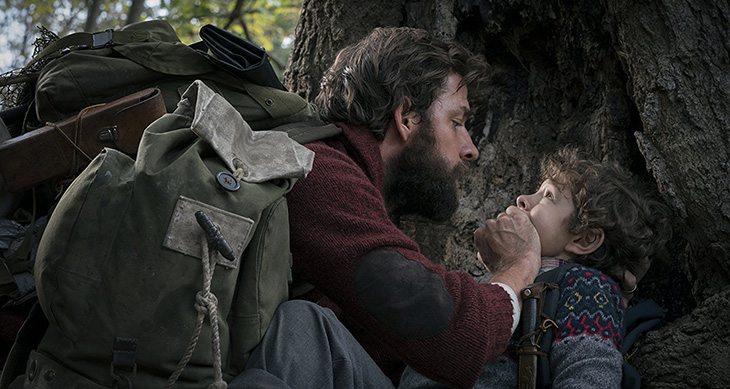Many people know “A Quiet Place” as a horror film about dangerous creatures that are drawn to sound. Perhaps more people know “A Quiet Place” as the horror film directed by John Krasinski of “The Office” fame, starring him and his real-life wife Emily Blunt. So, there are two keen camps of audiences looking forward to this movie, with a decent amount of overlap between horror fans and sitcom fans (and Krasinski fans). Is it good enough to please all of the eager hopefuls?
The premise is promising. In 2020, savage monsters of unknown origin lay siege to the planet, surviving the full force of the world’s military and whittling down humanity to a dystopian degree. Little is known about these creatures, other than an otherworldly sound sensitivity that helps them hunt and kill anyone who dares step on a crunchy leaf or creaky floorboard. By the time the film opens, Krasinski and his cinematic family are building new lives around scavenging and survival—and silence.
All of the above information is dispensed quietly. Krasinski, working from a script he wrote with Bryan Woods and Scott Beck, locks himself into the ‘show, don’t tell’ rule of screenwriting by virtue of the movie’s conceit. There is no dialogue with which to shovel exposition: “A Quiet Place” conveys plot points with newspaper clippings and concerned looks, dangling information on visual hooks that inform us while keeping us hungry for more. It rarely insults the viewer’s intelligence.

Krasinski’s hand as a director is just as steady as his storytelling. The film is expertly paced and shot, in service of both scares and plot. It’s a lean hour and a half that takes advantage of every minute. Krasinski’s passion for the project comes across loud and clear.
His decision to cast his actual partner as his fictional wife is a huge asset to the experience. The best horror films use aliens, demons, and the like to rip open the ribs of the human condition and expose the reasons behind our beating hearts —“A Quiet Place” is a portrait of familial bonds and what we’d do for those we love. Watching Emily Blunt and her actual husband interact reinforces that theme with tactile strength. Their care is, unsurprisingly, real.
There’s a father/daughter conflict that’s undercooked, but both performances are powerful enough to keep the conflict afloat when it’s not the movie’s focus. Millicent Simmonds, who is actually deaf, adds a further touch of realism to the story. Noah Jupe looks constantly worried, which also rings true—what kid wouldn’t be?
And yes, “A Quiet Place” is frightening. It hinges heavily on sound design, of course: every wayward sound is amplified to jump-scare levels, activating the tension of waiting for a creature to strike. Until the tension is diffused, or a terrifyingly designed monster makes it moves, Krasinski holds you in undying suspense, keeping your breath bated so that you don’t attract a bat-eared beast.
It’s all well and scary until the end. The movie focuses on the underdeveloped father/daughter conflict in its last act, which leads to some brave and emotional places, but the route there is unconvincing. And then there are the last few minutes. “A Quiet Place” ends with a couplet of twists that match “Signs” for sheer stupidity.
They’re less of a Shyamalan ‘the aliens invaded Earth despite being allergic to water’ reveal, and more of a ‘there is absolutely no way that people didn’t already try this’—twice in a row. They betray the backstory set up by newspapers and visual touches and are so no-holds-barred dumb that they leave plot holes in their wake.
But otherwise, “A Quiet Place” is an audacious and well-engineered horror film. Its tonal tightness and thematic integrity are rare in the genre today, so its nonsensical ending shouldn’t deter you, especially if you don’t mind a sour aftertaste.
★★★½ (3.5/5)




